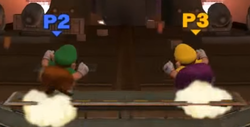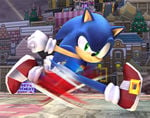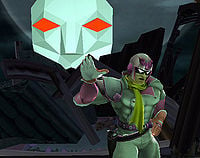Taunt match
A taunt match, colloquially referred to as a taunt party, is a type of match where players forego fighting in favour of taunting and not taking the battle seriously. Taunt matches have been primarily associated with online play, especially in Brawl, and they later became a large point of criticism for Brawl's online modes. Due to the often aggravating nature of unsolicited taunt matches, it's often seen as a form of organized griefing.
Taunt matches can theoretically be performed in any game mode and even see rare appearances in competitive play, often to the discontent of onlookers due to their uncompetitive nature. In an EVO 2015 qualifier match, for instance, smashers Manny and True Blue performed a partial taunt match where they both charged Sonic's Spin Dash for over a minute. Similarly, in Smash 4, in the Grand Finals of EVO 2018, CaptainZack and Lima responded to booing from the crowd by holding Bullet Climax for multiple minutes 14 minutes into the set, which can be considered a taunt match. There are many rules in place to prevent these situations, such as ones against stalling and other forms of poor sportsmanship.
Overview
Exact behavior in taunt matches varies from match to match, but the overall concept of generally not fighting others remains the same. Contrary to their name, taunt matches don't have to specifically feature excessive or non-stop taunting from players; moves that produce repetitive, loud noises can also be used by players, such as Ganondorf's up smash, Kirby's crouch animation, Charizard's Rock Smash, or Shulk's Back Slash. Like other forms of griefing, players can also abuse glitches, hack the game to display unusual stages (e.g. Target Smash stages), force desynchs, or increasing the lag seen on Wi-Fi via abusing moves such as Transform. Otherwise, players can act uselessly, such as by constantly backfiring Diddy Kong's Peanut Popgun, constantly breaking their shield, moving back and forth via crawling, walking or dashing, edge running, or even completely refraining from performing any actions. Costumes can also play a role in taunt matches, with players often choosing "flashy" and "flamboyant" costumes such as pink palette swaps (most infamously with Captain Falcon) and Shulk's shirtless costume. In Brawl, Temple was a common pick amongst taunt matches, as its large size allowed players to easily avoid serious players, though the deadly stage hazards of New Pork City made that stage a relatively common pick as well.
A sense of cooperation is generally seen in taunt matches, with most of them involving a group of either two or three people all working together in the match. Very cooperative players may use the same character to synchronize taunts or to otherwise assist in preventing serious matches from occurring. Etiquette is also often displayed by those who start taunt matches; accidental attacks are sometimes followed up with the offending player crouching as a form of apology, likely to escape potential backlash.
Serious players often attempt to "force" the taunt match to end, but the presence of multiple players can make this almost impossible. Players who wish to keep the taunt match going may either constantly run away from the serious player via the aid of large stages, crowd in the same area to create a near-impregnable camping tactic, or team up on the serious player. In this regard, the use of Mr. Game & Watch is popular with characters such as Samus or Ness, due to his Oil Panic move allowing it to easily be refilled and quickly one-hit KO the serious player. However, being ganged up on by what's often 3 players is more than enough to make it almost impossible for an average player to win.
In Super Smash Bros. Brawl
The anonymity of Basic Brawl allowed for numerous taunt matches to occur. In addition to numerous other perceived flaws with the mode, the inability to avoid taunt matches via a preferred rule system or similar method caused Basic Brawl to garner considerable criticism from serious players. The lack of a reporting system to ban or restrict players for griefing was also problematic, allowing taunt matches to thrive. The sheer amount of taunt matches in Brawl also made Spectator Mode a near-useless feature, as it made it almost impossible to find serious matches to watch and bet on.
In Super Smash Bros. 4

In response to the heavy criticism of Brawl's online game modes, Smash 4 added various systems in an attempt to combat players who attempt taunt matches and other griefing behaviours. Among the offenses that players can be temporarily banned for include refraining from fighting, relentlessly targeting a specific player, intentionally self-destructing in a short period of time, and "other abuses of the system", such as disconnecting. Additionally, there is a limit to how often players can taunt during a match in With Anyone mode. Once the limit is reached, players are prevented from using taunts. The initial limit is 2, but scoring a KO allows a player to taunt again. This limit actually has a negative effect on certain characters, such as Kirby, who is unable to discard a copy ability once the limit is reached.
Taunt matches are still a fairly common occurrence, particularly in For Fun. However, as a result of the taunting limit, they are not nearly as ubiquitous as they were in Brawl. As such, SSB4 taunt matches did not reach the same level of notoriety as they did in Brawl, especially because they can be largely avoided by playing For Glory, which has a more competitive ruleset in place that makes it difficult for them to succeed as they used to.
To circumvent the taunt limit in online play, players who take part in taunt matches instead often use characters such as Wario and King Dedede, which have repetitive or aggravating attack animations and sounds, as their attacks can be used as pseudo-taunts that can bypass the taunt limit. However, since idling and griefing players often leads to temporary bans, taunt matches remain difficult to successfully pull off.
Some casual players criticised Smash 4's heavy-handed attempts to restrict taunt matches, as they did enjoy the cooperation and funny interactions (such as showing off glitches) that would often come with them. Players would often argue that For Fun shouldn't have had a taunt limit and should have been more hands-off with bans.
In Super Smash Bros. Ultimate
Taunt matches still exist in Ultimate, but are almost nonexistent on Quickplay due to other systems being added or otherwise improved, such as preferred rules having a heavy influence on matchmaking. As taunts are banned on Quickplay — except for Kirby, who can now taunt if he has a Copy Ability in order to discard it — players using random matchmaking cannot engage in "true" taunt matches. When taunt matches do occur, pseudo-taunting by repeatedly crouching (teabagging) is an extremely common substitute for true taunt matches on Quickplay.
With the addition of Battle Arenas, however, taunt matches have been allowed to coexist with serious play by creating dedicated arenas, which can be seen as a more equitable solution to Smash 4's more heavy-handed approach. Battle Arenas allow players to indulge in taunt matches with unlimited access to all taunts without any automatic ban systems. Battle Arenas involving taunt matches are typically labelled with the "Playground" descriptor, often accompanied by an appropriate message, such as "No fighting". Thus, players no longer need to use random matchmaking to seek taunt matches, leading to their continued decline on Quickplay.
Trivia
- Super Smash Bros. Ultimate attempts to circumvent taunt matches entirely by not allowing taunts to be used in Quickplay. Nonetheless, a commercial for the game shows two Warios using synchronized Wario Wafts and taunts in a manner that was popular in SSB4 taunt matches.

